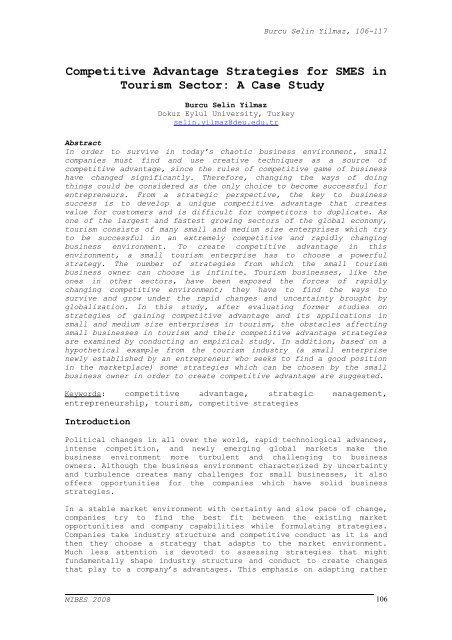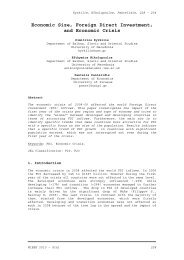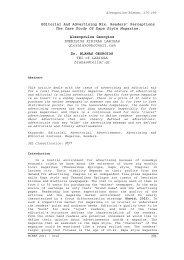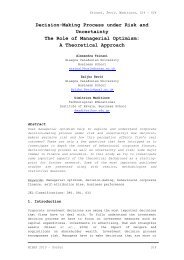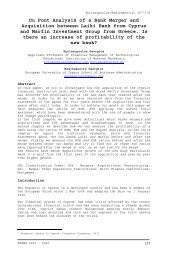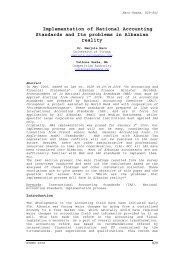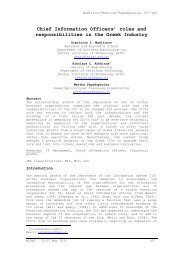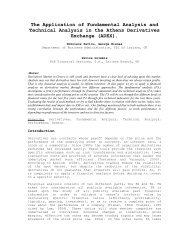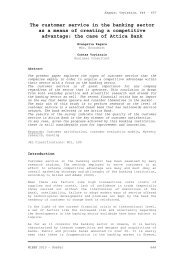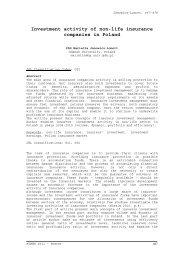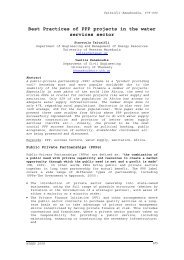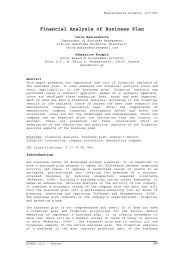Yilmaz B. S., Competitive Advantage Strategies for SMES in ... - mibes
Yilmaz B. S., Competitive Advantage Strategies for SMES in ... - mibes
Yilmaz B. S., Competitive Advantage Strategies for SMES in ... - mibes
Create successful ePaper yourself
Turn your PDF publications into a flip-book with our unique Google optimized e-Paper software.
Burcu Sel<strong>in</strong> <strong>Yilmaz</strong>, 106-117<br />
<strong>Competitive</strong> <strong>Advantage</strong> <strong>Strategies</strong> <strong>for</strong> <strong>SMES</strong> <strong>in</strong><br />
Tourism Sector: A Case Study<br />
Burcu Sel<strong>in</strong> <strong>Yilmaz</strong><br />
Dokuz Eylul University, Turkey<br />
sel<strong>in</strong>.yilmaz@deu.edu.tr<br />
Abstract<br />
In order to survive <strong>in</strong> today’s chaotic bus<strong>in</strong>ess environment, small<br />
companies must f<strong>in</strong>d and use creative techniques as a source of<br />
competitive advantage, s<strong>in</strong>ce the rules of competitive game of bus<strong>in</strong>ess<br />
have changed significantly. There<strong>for</strong>e, chang<strong>in</strong>g the ways of do<strong>in</strong>g<br />
th<strong>in</strong>gs could be considered as the only choice to become successful <strong>for</strong><br />
entrepreneurs. From a strategic perspective, the key to bus<strong>in</strong>ess<br />
success is to develop a unique competitive advantage that creates<br />
value <strong>for</strong> customers and is difficult <strong>for</strong> competitors to duplicate. As<br />
one of the largest and fastest grow<strong>in</strong>g sectors of the global economy,<br />
tourism consists of many small and medium size enterprises which try<br />
to be successful <strong>in</strong> an extremely competitive and rapidly chang<strong>in</strong>g<br />
bus<strong>in</strong>ess environment. To create competitive advantage <strong>in</strong> this<br />
environment, a small tourism enterprise has to choose a powerful<br />
strategy. The number of strategies from which the small tourism<br />
bus<strong>in</strong>ess owner can choose is <strong>in</strong>f<strong>in</strong>ite. Tourism bus<strong>in</strong>esses, like the<br />
ones <strong>in</strong> other sectors, have been exposed the <strong>for</strong>ces of rapidly<br />
chang<strong>in</strong>g competitive environment; they have to f<strong>in</strong>d the ways to<br />
survive and grow under the rapid changes and uncerta<strong>in</strong>ty brought by<br />
globalization. In this study, after evaluat<strong>in</strong>g <strong>for</strong>mer studies on<br />
strategies of ga<strong>in</strong><strong>in</strong>g competitive advantage and its applications <strong>in</strong><br />
small and medium size enterprises <strong>in</strong> tourism, the obstacles affect<strong>in</strong>g<br />
small bus<strong>in</strong>esses <strong>in</strong> tourism and their competitive advantage strategies<br />
are exam<strong>in</strong>ed by conduct<strong>in</strong>g an empirical study. In addition, based on a<br />
hypothetical example from the tourism <strong>in</strong>dustry (a small enterprise<br />
newly established by an entrepreneur who seeks to f<strong>in</strong>d a good position<br />
<strong>in</strong> the marketplace) some strategies which can be chosen by the small<br />
bus<strong>in</strong>ess owner <strong>in</strong> order to create competitive advantage are suggested.<br />
Keywords: competitive advantage, strategic management,<br />
entrepreneurship, tourism, competitive strategies<br />
Introduction<br />
Political changes <strong>in</strong> all over the world, rapid technological advances,<br />
<strong>in</strong>tense competition, and newly emerg<strong>in</strong>g global markets make the<br />
bus<strong>in</strong>ess environment more turbulent and challeng<strong>in</strong>g to bus<strong>in</strong>ess<br />
owners. Although the bus<strong>in</strong>ess environment characterized by uncerta<strong>in</strong>ty<br />
and turbulence creates many challenges <strong>for</strong> small bus<strong>in</strong>esses, it also<br />
offers opportunities <strong>for</strong> the companies which have solid bus<strong>in</strong>ess<br />
strategies.<br />
In a stable market environment with certa<strong>in</strong>ty and slow pace of change,<br />
companies try to f<strong>in</strong>d the best fit between the exist<strong>in</strong>g market<br />
opportunities and company capabilities while <strong>for</strong>mulat<strong>in</strong>g strategies.<br />
Companies take <strong>in</strong>dustry structure and competitive conduct as it is and<br />
then they choose a strategy that adapts to the market environment.<br />
Much less attention is devoted to assess<strong>in</strong>g strategies that might<br />
fundamentally shape <strong>in</strong>dustry structure and conduct to create changes<br />
that play to a company’s advantages. This emphasis on adapt<strong>in</strong>g rather<br />
MIBES 2008 106
Burcu Sel<strong>in</strong> <strong>Yilmaz</strong>, 106-117<br />
than shap<strong>in</strong>g is natural <strong>in</strong> stable bus<strong>in</strong>ess environments, where key<br />
elements of <strong>in</strong>dustry structure and conduct – such as technology<br />
plat<strong>for</strong>ms, regulations, competitors, and customer purchas<strong>in</strong>g patterns<br />
– appear to be locked-<strong>in</strong> and difficult to change.<br />
In more uncerta<strong>in</strong> markets, however, many of these key elements may be<br />
<strong>in</strong>decisive and unstable, and hence susceptible to be<strong>in</strong>g shaped. A<br />
company’s decision to adopt a new technology, <strong>for</strong> example, may help<br />
establish that technology as the <strong>in</strong>dustry standard. Under what<br />
circumstances should companies attempt to proactively shape uncerta<strong>in</strong><br />
<strong>in</strong>dustry structure and conduct, and when is it better to reactively<br />
adapt to <strong>in</strong>dustry changes over time?<br />
Whether a company chooses to shape or adapt, strategy <strong>in</strong>variably<br />
<strong>in</strong>volves mak<strong>in</strong>g at least some major commitments that are difficult to<br />
reverse. These <strong>in</strong>clude acquisitions, capital <strong>in</strong>vestments, and choices<br />
about the design of the bus<strong>in</strong>ess system. The tim<strong>in</strong>g of such<br />
commitments is often the key to build<strong>in</strong>g and susta<strong>in</strong><strong>in</strong>g competitive<br />
advantage. In today’s global competitive environment, any bus<strong>in</strong>ess,<br />
large or small, that could not th<strong>in</strong>k and act strategically is<br />
extremely vulnerable.<br />
The rules of competitive game of bus<strong>in</strong>ess have changed dramatically.<br />
To be successful, companies can no longer do th<strong>in</strong>gs <strong>in</strong> the way they<br />
have always done them. Fortunately, successful companies have a<br />
powerful weapon to cope with a hostile, ever-chang<strong>in</strong>g, and uncerta<strong>in</strong><br />
bus<strong>in</strong>ess environment: the process of develop<strong>in</strong>g competitive advantage<br />
strategies.<br />
As one of the fastest grow<strong>in</strong>g <strong>in</strong>dustries of the global economy, the<br />
tourism <strong>in</strong>dustry consists of many small and medium size enterprises<br />
which try to be successful <strong>in</strong> an extremely competitive and rapidly<br />
chang<strong>in</strong>g bus<strong>in</strong>ess environment. To create competitive advantage <strong>in</strong> this<br />
environment, a small tourism enterprise has to choose a powerful<br />
strategy. The number of strategies from which the small tourism<br />
bus<strong>in</strong>ess owner can choose is <strong>in</strong>f<strong>in</strong>ite.<br />
This paper builds a theoretical background and provides propositions<br />
show<strong>in</strong>g how competitive advantage strategies are applied <strong>in</strong> small and<br />
medium-sized enterprises <strong>in</strong> the tourism <strong>in</strong>dustry. After evaluat<strong>in</strong>g<br />
<strong>for</strong>mer studies on competitive advantage and its applications <strong>in</strong> small<br />
and medium-sized enterprises <strong>in</strong> the tourism <strong>in</strong>dustry, based on a<br />
hypothetical example structured on an empirical study on the obstacles<br />
affect<strong>in</strong>g small bus<strong>in</strong>esses <strong>in</strong> tourism and their competitive advantage<br />
strategies, some competitive advantage strategies are suggested <strong>for</strong><br />
small and medium-sized enterprises <strong>in</strong> tourism.<br />
SMEs and SMEs <strong>in</strong> Tourism<br />
In today’s globalized world, SMEs have become more important <strong>for</strong> both<br />
developed and develop<strong>in</strong>g countries s<strong>in</strong>ce they generate significant<br />
percentages of overall production and employment. Def<strong>in</strong>itions of SMEs<br />
vary from country to country. Number of employees and total turnover<br />
-depend<strong>in</strong>g on the <strong>in</strong>dustry- are used as measures by The North American<br />
Industry Classification System. The European Union (EU) has created a<br />
uni<strong>for</strong>m def<strong>in</strong>ition: SMEs are <strong>in</strong>dependent enterprises which employ<br />
fewer than 250 persons and which have an annual turnover not exceed<strong>in</strong>g<br />
50 million euro and/or an annual balance sheet total not exceed<strong>in</strong>g 43<br />
MIBES 2008 107
Burcu Sel<strong>in</strong> <strong>Yilmaz</strong>, 106-117<br />
million euro. This def<strong>in</strong>ition has been adopted, with modifications, by<br />
most member states of EU and some non-EU countries (Eikebrokk and<br />
Olsen, 2007).<br />
Turkey's SME policy is guided by its SME strategy and action plan<br />
prepared <strong>in</strong> 2003 <strong>in</strong> l<strong>in</strong>e with the European Charter <strong>for</strong> Small<br />
Enterprises as well as by the national development plan, the mediumterm,<br />
and the annual programmes. The Small and Medium Industry<br />
Development Organisation (KOSGEB) runs a multitude of support schemes<br />
<strong>in</strong> the areas of consultancy/tra<strong>in</strong><strong>in</strong>g, technological<br />
development/<strong>in</strong>novation, <strong>in</strong>ternational cooperation, export promotion,<br />
entrepreneurship development, <strong>in</strong><strong>for</strong>mation technology, quality<br />
improvement and regional development. Turkey's SME def<strong>in</strong>ition is<br />
largely <strong>in</strong> l<strong>in</strong>e with the EU def<strong>in</strong>ition except <strong>for</strong> its annual turnover<br />
threshold, which is considerably below the EU's. KOSGEB's SME support<br />
programmes have been aligned with the new SME def<strong>in</strong>ition <strong>in</strong> June 2006.<br />
KOSGEB data verifies that 99.8 percent of Turkey’s economy is made up<br />
of SMEs. However, the share of SMEs <strong>in</strong> overall employment stands at<br />
76.7 percent, its share <strong>in</strong> <strong>in</strong>vestments 56.5 percent. The added value<br />
they have created is 38 percent and their direct contribution to<br />
exports is around 10 percent (KOSGEB, 2007).<br />
Small and medium enterprises (SMEs) have begun to play a critical role<br />
<strong>in</strong> not only national trade but also <strong>in</strong> <strong>in</strong>ternational trade. Statistics<br />
from the Organization <strong>for</strong> Economic Cooperation and Development (OECD)<br />
and other sources <strong>in</strong>dicate that SMEs now account <strong>for</strong> a very<br />
substantial proportion of exports from most <strong>in</strong>dustrialized nations<br />
(Knight, 2001, p.155).<br />
The significance of new firms <strong>in</strong> job generation, <strong>in</strong>novation, and<br />
economic change is widely accepted, and tourism SMEs are assigned an<br />
important role as an aid to regional development. They are labor<br />
<strong>in</strong>tensive and frequently multi-task<strong>in</strong>g, thus allow<strong>in</strong>g <strong>for</strong> flexibility<br />
<strong>in</strong> meet<strong>in</strong>g the needs of their customers. On the other hand, many of<br />
them are family enterprises so as to there are sufficient <strong>in</strong>stances of<br />
those with little market stability, low levels of capital <strong>in</strong>vestment,<br />
weak management skills and resistance to advice or change, which cause<br />
barriers to successful tourism development. The solution to<br />
difficulties of this k<strong>in</strong>d that tends to be adopted by government<br />
agencies <strong>in</strong> the field is to identify good practices that can be held<br />
up as exemplars. Action is then taken to try and upgrade standards<br />
through “benchmark<strong>in</strong>g”, shar<strong>in</strong>g best practice, provid<strong>in</strong>g f<strong>in</strong>ancial<br />
support, and <strong>in</strong>vest<strong>in</strong>g <strong>in</strong> the skills of the labor <strong>for</strong>ce. Tourism SMEs<br />
fulfill a dual role of on the one hand be<strong>in</strong>g an <strong>in</strong>novative and<br />
enterpris<strong>in</strong>g <strong>for</strong>ce <strong>in</strong> the local economy and on the other a reservoir<br />
of hidden unemployment (people creat<strong>in</strong>g their own work). In this<br />
respect, develop<strong>in</strong>g countries are not too different from mature<br />
economies, where it is observed that small bus<strong>in</strong>ess start-ups<br />
accelerate dur<strong>in</strong>g a recession (Wanhill, 2000). With<strong>in</strong> the hospitality,<br />
tourism and leisure <strong>in</strong>dustries, while there are a large number of<br />
multi-national cha<strong>in</strong>s, the <strong>in</strong>dustries are still dom<strong>in</strong>ated by a<br />
substantial volume of small, entrepreneurial enterprises.<br />
The <strong>Competitive</strong> <strong>Advantage</strong> Concept<br />
There has been comparatively little research that explores competitive<br />
advantage <strong>in</strong> small firms as compared to studies of competitive<br />
advantage <strong>in</strong> large companies. That competitive advantage <strong>in</strong> the<br />
MIBES 2008 108
Burcu Sel<strong>in</strong> <strong>Yilmaz</strong>, 106-117<br />
smaller firm often arises accidentally as a result of particular<br />
operat<strong>in</strong>g conditions surround<strong>in</strong>g the enterprise could be shown as one<br />
of the ma<strong>in</strong> reasons (Jenn<strong>in</strong>gs and Beaver, 1997). In addition, it is<br />
thought that traditional competitive advantage models are not<br />
completely applicable <strong>for</strong> smaller firms because they assume the<br />
existence of scale economies and it is recognized that small firms<br />
cannot compete with larger organizations <strong>in</strong> terms of economies of<br />
scale (O’Donnell, Gilmore, Carson and Cumm<strong>in</strong>s, 2002, p.207).<br />
Complete understand<strong>in</strong>g of a competitive advantage requires a complex,<br />
multidimensional portrayal of all po<strong>in</strong>ts of superiority or deficiency<br />
between a bus<strong>in</strong>ess and its competitors (Day and Nedungadi, 1994). The<br />
creation of a competitive advantage through the development of a<br />
competitive strategy entails the ability to compare the firm’s<br />
position with its competitors. Porter (1991) claimed that, when<br />
<strong>for</strong>mulat<strong>in</strong>g a competitive strategy, managers should be able to<br />
identify the competitors constitut<strong>in</strong>g their <strong>in</strong>dustry. <strong>Competitive</strong><br />
advantage has been used <strong>in</strong>terchangeably with “dist<strong>in</strong>ctive competence”<br />
to mean comparative superiority <strong>in</strong> skills and resources. <strong>Competitive</strong><br />
advantage is often appraised <strong>in</strong> relation to <strong>in</strong>dustry structures,<br />
products, markets, customers, strategies, and communication. It has<br />
also been used <strong>for</strong> describ<strong>in</strong>g positions of superiority based upon the<br />
provision of superior customer value or the achievement of lower<br />
relative costs and the result<strong>in</strong>g market share and profitability<br />
per<strong>for</strong>mance. The sources of competitive advantage <strong>for</strong> firms are<br />
superior skills and resources (Day and Wensley, 1988). These sources<br />
of advantage act as structural determ<strong>in</strong>ants or drivers of cost or<br />
differentiation advantages (Porter, 1985). An organization’s<br />
capabilities can lead to a positional advantage based upon <strong>in</strong>novative<br />
offer<strong>in</strong>gs or superior service. Companies that possess such an<br />
advantage could have superior per<strong>for</strong>mance. The resource based view<br />
(RBV) perspective focuses serious attention on resources, which can be<br />
def<strong>in</strong>ed as assets that are tied semi-permanently to the firm (Hult and<br />
Ketchen, 2001, p.900). Resources are the tangible and <strong>in</strong>tangible<br />
assets a firm uses to choose and implement its strategies (Barney,<br />
2001; p.54). Accord<strong>in</strong>g to the RBV, unique assets, such as patents and<br />
reputations, are more important than others. Unique assets are<br />
difficult <strong>for</strong> competitors to replicate and thus serve to differentiate<br />
their possessors. It is suggested that market orientation,<br />
entrepreneurship, <strong>in</strong>novation, and organizational learn<strong>in</strong>g constitute<br />
unique resources <strong>in</strong>dependently, but rather that they can collectively<br />
contribute to the creation of a unique resource. Each of these four<br />
elements are necessary but are not <strong>in</strong>dividually sufficient <strong>for</strong><br />
creat<strong>in</strong>g positional advantage. Each element is adequate to offer<br />
strengths, but together they can help a firm be uniquely competitive<br />
(Hult and Ketchen, 2001, p.900).<br />
Entrepreneurship refers to the quest of new market opportunities and<br />
the renewal of exist<strong>in</strong>g areas of operation. Entrepreneurial<br />
organizations could per<strong>for</strong>m well <strong>in</strong> dynamic environments, but not <strong>in</strong><br />
regulated markets. They have low per<strong>for</strong>mance <strong>in</strong> stable environments<br />
because the slow pace of change <strong>in</strong> these sett<strong>in</strong>gs rewards efficiently<br />
exploit<strong>in</strong>g extant opportunities, not aggressiveness. There<strong>for</strong>e,<br />
entrepreneurship could be beneficial <strong>in</strong> many contexts, but does not,<br />
by itself, provide a susta<strong>in</strong>able competitive advantage (Hult and<br />
Ketchen, 2001; pp.901-902).<br />
Innovativeness is present when the implementation of new ideas,<br />
products, or processes is encouraged. Innovation is a critical<br />
MIBES 2008 109
Burcu Sel<strong>in</strong> <strong>Yilmaz</strong>, 106-117<br />
complement to entrepreneurship because an organization that pursues<br />
new opportunities, but is not <strong>in</strong>novative <strong>in</strong> meet<strong>in</strong>g the desires of the<br />
market, is unlikely to enjoy long-term success. In addition,<br />
<strong>in</strong>novation alone does not guarantee success. Organizational learn<strong>in</strong>g<br />
refers to the generation of new <strong>in</strong>sights that have the potential to<br />
reshape behavior. An organization can extract lessons from both<br />
successes and failures <strong>in</strong> order to develop better tools to be<br />
competitive. Like entrepreneurship and <strong>in</strong>novation, organizational<br />
learn<strong>in</strong>g alone is not sufficient to develop susta<strong>in</strong>ed advantages (Hult<br />
and Ketchen, 2001, pp.901-902).<br />
Companies can achieve competitive advantage by conceiv<strong>in</strong>g new ways to<br />
conduct the activities of the value-cha<strong>in</strong> <strong>in</strong> order to deliver superior<br />
value to customers, which may be def<strong>in</strong>ed as an act of <strong>in</strong>novation<br />
(Porter, 1985). It is seen that <strong>in</strong>novation and the competitive<br />
advantage process are <strong>in</strong>ter-connected. However, empirical evidence<br />
shows that <strong>in</strong>novation leads to susta<strong>in</strong>ed competitive advantage has<br />
been conf<strong>in</strong>ed to manufactur<strong>in</strong>g <strong>in</strong>dustries. While the importance of<br />
<strong>in</strong>novation <strong>for</strong> national competitiveness and economic growth is<br />
recognized, services are viewed as <strong>in</strong>novation laggards that make<br />
little or no contribution to either productivity or growth. However,<br />
<strong>in</strong> addition to an <strong>in</strong>creas<strong>in</strong>g strength of competition and changes <strong>in</strong><br />
technology, the move by organizations to a major dependence on<br />
services would po<strong>in</strong>t to the importance of <strong>in</strong>novation as a key<br />
component <strong>for</strong> competitive advantage <strong>for</strong> service firms (Weerawardena<br />
and McColl-Kennedy, 2002, p.13). A number of key characteristics of<br />
services differs them from products. Some of these characteristics<br />
are (Miles, 1993; Weerawardena and McColl-Kennedy, 2002, p.14): (a) a<br />
close <strong>in</strong>teraction between production and consumption (co-term<strong>in</strong>ality),<br />
(b) a high <strong>in</strong><strong>for</strong>mation- <strong>in</strong>tangible content of services products and<br />
processes, (c) an important role played by human resources as a key<br />
competitive factor and (d) a critical role played by organizational<br />
factors <strong>for</strong> the firm’s per<strong>for</strong>mance.<br />
Creat<strong>in</strong>g <strong>Competitive</strong> <strong>Advantage</strong> <strong>in</strong> SMEs<br />
Small firms and start-up ventures have been skilled <strong>in</strong> develop<strong>in</strong>g<br />
<strong>in</strong>novations <strong>in</strong> order to exploit profitable market opportunities but<br />
less effective at susta<strong>in</strong><strong>in</strong>g the competitive advantages that are based<br />
on dist<strong>in</strong>guished firm-specific resources needed to exploit those<br />
opportunities over time. The study of Hyvonen and Tuom<strong>in</strong>en (2006)<br />
shows that technological <strong>in</strong>novation capability and strong<br />
relationships with customers and supply cha<strong>in</strong> partners are the key<br />
determ<strong>in</strong>ants of positional and economic per<strong>for</strong>mance advantages <strong>in</strong><br />
SMEs. Small and medium-sized firms’ commitment to learn<strong>in</strong>g strengthens<br />
their position <strong>in</strong> the marketplace.<br />
Recent studies have shown that small firms produce more economically<br />
and technically important <strong>in</strong>novations than larger firms. The<br />
entrepreneurial secret <strong>for</strong> creat<strong>in</strong>g value <strong>in</strong> the marketplace is<br />
apply<strong>in</strong>g creativity and <strong>in</strong>novation to solve problems and to exploit<br />
opportunities that people face every day. Briefly, entrepreneurs<br />
succeed by th<strong>in</strong>k<strong>in</strong>g and do<strong>in</strong>g new th<strong>in</strong>gs or old th<strong>in</strong>gs <strong>in</strong> new ways.<br />
Small companies must use creative techniques as one source of<br />
competitive advantage (Zimmerer and Scarborough, 2005). One of the<br />
fundamental questions of competitive strategy is: Where does a company<br />
have an edge over its rivals? In dynamic environments, the sources and<br />
nature of these advantages often experience rapid changes. Firstly, a<br />
MIBES 2008 110
Burcu Sel<strong>in</strong> <strong>Yilmaz</strong>, 106-117<br />
company must determ<strong>in</strong>e the mean<strong>in</strong>gful set of competitors <strong>in</strong> order to<br />
assess its advantages over rivals. Secondly, after determ<strong>in</strong><strong>in</strong>g<br />
relevant set of competitors, the second question is: Does the company<br />
have a susta<strong>in</strong>able edge over the competition? A three step process can<br />
be helpful <strong>in</strong> determ<strong>in</strong><strong>in</strong>g the company’s susta<strong>in</strong>able edge. This process<br />
is part of never-end<strong>in</strong>g cycle of creation and erosion of advantages<br />
that must be mastered to achieve superior profitability (Day and<br />
Reibste<strong>in</strong>, 1997, p.21):<br />
• The first step asks whether the company has demonstrated that it has<br />
an advantage by deliver<strong>in</strong>g superior customer value.<br />
• The second step is to understand the sources of these advantages.<br />
These are the superior assets and dist<strong>in</strong>ctive capabilities that set<br />
the organization apart from competitors.<br />
• The third asks how long these advantages can be susta<strong>in</strong>ed by putt<strong>in</strong>g<br />
impediments <strong>in</strong> the way of competitors’ ef<strong>for</strong>ts to imitate, and<br />
<strong>in</strong>vest<strong>in</strong>g to renovate the advantages or f<strong>in</strong>d new ones.<br />
Potentially effective strategies <strong>in</strong> competitive advantages of small<br />
bus<strong>in</strong>ess ventures can be summarized as follows (Meredith, 1988, pp.28-<br />
31):<br />
• serv<strong>in</strong>g personalized services to customers<br />
• flexibility and adaptability<br />
• specialized and customized products and services<br />
• effective and quick decision mak<strong>in</strong>g process<br />
• employer and employee motivation based on close relationships<br />
• geographic specialization<br />
Build<strong>in</strong>g a competitive advantage alone is not enough; the key to<br />
success is build<strong>in</strong>g a susta<strong>in</strong>able competitive advantage (Wickham,<br />
2006; Zimmerer and Scarborough, 2005). In the long run, a company<br />
ga<strong>in</strong>s a susta<strong>in</strong>able competitive advantage through its ability to<br />
develop a set of core competencies that enables it to serve its<br />
selected target customers better than its rivals. Core competencies<br />
are a unique set of capabilities that a company develops <strong>in</strong> key areas,<br />
such as superior quality, customer service, <strong>in</strong>novation, team build<strong>in</strong>g,<br />
flexibility, responsiveness, and others that allow it to leave beh<strong>in</strong>d<br />
its competitors (Zimmerer and Scarborough, 2005, p.69). When it comes<br />
to develop<strong>in</strong>g a strategy <strong>for</strong> establish<strong>in</strong>g a competitive advantage,<br />
small companies have a range of natural advantages over their larger<br />
competitors. Small bus<strong>in</strong>esses often have narrower product l<strong>in</strong>es, more<br />
clearly def<strong>in</strong>ed customer bases, and more specific geographic market<br />
areas than big bus<strong>in</strong>esses. Because of the simplicity of their<br />
organizational structures, small bus<strong>in</strong>ess owners are <strong>in</strong> touch with<br />
employees daily, often work<strong>in</strong>g side by side with them, allow<strong>in</strong>g them<br />
to communicate strategic moves firsthand. Consequently, small<br />
bus<strong>in</strong>esses f<strong>in</strong>d that strategic management comes more naturally to them<br />
than larger companies with their layers of bureaucracy and widerang<strong>in</strong>g<br />
operations (Zimmerer and Scarborough, 2005).<br />
A Research on Small Bus<strong>in</strong>esses <strong>in</strong> Tourism<br />
In order to determ<strong>in</strong>e the obstacles affect<strong>in</strong>g small bus<strong>in</strong>esses <strong>in</strong><br />
tourism sector and exam<strong>in</strong>e their competitive advantage strategies a<br />
research is conducted at lodg<strong>in</strong>g enterprises <strong>in</strong> Izmir, Turkey. Data<br />
are collected by <strong>in</strong>terviews with managers of selected lodg<strong>in</strong>g<br />
MIBES 2008 111
Burcu Sel<strong>in</strong> <strong>Yilmaz</strong>, 106-117<br />
enterprises (14 managers were chosen <strong>for</strong> the <strong>in</strong>terviews) <strong>in</strong> order to<br />
exam<strong>in</strong>e views on problems of small bus<strong>in</strong>esses <strong>in</strong> tourism and<br />
competitive advantage strategies of small lodg<strong>in</strong>g enterprises.<br />
Interviews are conducted face-to-face, via phone or via e-mail. The<br />
ma<strong>in</strong> aim of this research is to determ<strong>in</strong>e the perception of the<br />
managers about these concepts.<br />
The case is structured on the results of <strong>in</strong>terviews with managers of<br />
small and medium sized accommodation establishments. In order to<br />
prepare the case 14 small and medium sized accommodation<br />
establishments (hotels) located <strong>in</strong> Aegean Region (Turkey) were chosen<br />
and a couple of questions related to obstacles affect<strong>in</strong>g small<br />
bus<strong>in</strong>esses <strong>in</strong> tourism and competitive advantage were asked to their<br />
managers. Based on the results of the <strong>in</strong>terviews a simple case was<br />
written. The results of the <strong>in</strong>terviews are summarised <strong>in</strong> Table 1.<br />
Table 1: Summary of <strong>in</strong>terview results<br />
Questions<br />
What are the<br />
obstacles<br />
affect<strong>in</strong>g<br />
small<br />
bus<strong>in</strong>esses <strong>in</strong><br />
tourism?<br />
Hotel 1 F<strong>in</strong>ancial<br />
problems,<br />
bureaucratic<br />
obstacles,<br />
lack of<br />
qualified<br />
employees,<br />
fierce<br />
competition<br />
Hotel 2 F<strong>in</strong>ancial<br />
problems,<br />
lack of<br />
qualified<br />
employees,<br />
lack of<br />
<strong>in</strong>novation<br />
Hotel 3 F<strong>in</strong>ancial<br />
problems,<br />
high costs,<br />
and quality<br />
deficiencies<br />
Hotel 4 Lack of<br />
qualified<br />
employees,<br />
market<strong>in</strong>g<br />
problems, and<br />
f<strong>in</strong>ancial<br />
problems<br />
Hotel 5<br />
Difficulties<br />
<strong>in</strong> prepar<strong>in</strong>g<br />
a strategic<br />
plan,<br />
f<strong>in</strong>ancial<br />
problems,<br />
barriers to<br />
<strong>in</strong>stitutional<br />
ization<br />
Determ<strong>in</strong><strong>in</strong>g<br />
competitive<br />
strategies<br />
is;<br />
Difficult but<br />
important<br />
In order to<br />
create<br />
competitive<br />
advantage <strong>in</strong><br />
tourism<br />
companies<br />
should;<br />
Customize<br />
their<br />
services and<br />
serve better<br />
than their<br />
competitors.<br />
Vital Be more<br />
responsive to<br />
their<br />
customers and<br />
be ready to<br />
change.<br />
Timeconsum<strong>in</strong>g<br />
and<br />
complex<br />
Determ<strong>in</strong>ant<br />
of survival<br />
Strategic and<br />
important<br />
Control their<br />
costs and<br />
improve<br />
service<br />
quality.<br />
Be more<br />
responsive to<br />
their<br />
customers,<br />
build a good<br />
image, and be<br />
flexible<br />
Have a more<br />
scientific<br />
approach to<br />
management,<br />
apply<br />
strategic<br />
management<br />
pr<strong>in</strong>ciples,<br />
be more<br />
flexible and<br />
responsive to<br />
the customer<br />
needs<br />
What are your<br />
enterprise’s<br />
ma<strong>in</strong><br />
competitive<br />
advantages?<br />
Service<br />
quality,<br />
different<br />
services than<br />
our<br />
competitors<br />
Customer<br />
relations,<br />
new services,<br />
and awareness<br />
of the<br />
changes <strong>in</strong><br />
the sector<br />
Service<br />
quality<br />
Brand name,<br />
image,<br />
customer<br />
relations<br />
Better<br />
relationships<br />
with<br />
customers and<br />
other<br />
stakeholders<br />
In order to<br />
ga<strong>in</strong> bus<strong>in</strong>ess<br />
success, you<br />
should;<br />
Be better<br />
than your<br />
competitors,<br />
control your<br />
costs<br />
tightly.<br />
Be better<br />
than your<br />
competitors,<br />
and give<br />
importance to<br />
customer<br />
relations.<br />
Maximize your<br />
profit and<br />
control your<br />
costs<br />
tightly.<br />
Give<br />
importance to<br />
customer<br />
relations,<br />
and build a<br />
good<br />
reputation<br />
and image.<br />
Be better<br />
than your<br />
competitors,<br />
give<br />
importance to<br />
customer<br />
relations,<br />
and apply<br />
strategic<br />
management.<br />
MIBES 2008 112
Burcu Sel<strong>in</strong> <strong>Yilmaz</strong>, 106-117<br />
Table 1: Summary of <strong>in</strong>terview results (cont’d)<br />
Hotel 6<br />
Hotel 7<br />
Hotel 8<br />
Hotel 9<br />
Hotel 10<br />
Hotel 11<br />
Hotel 12<br />
Hotel 13<br />
Hotel 14<br />
F<strong>in</strong>ancial<br />
problems and<br />
lack of<br />
expertise<br />
F<strong>in</strong>ancial<br />
problems,<br />
lack of<br />
qualified<br />
employees,<br />
and<br />
uncerta<strong>in</strong>ty<br />
<strong>in</strong> bus<strong>in</strong>ess<br />
environment<br />
F<strong>in</strong>ancial<br />
problems,<br />
uncerta<strong>in</strong>ty<br />
<strong>in</strong> bus<strong>in</strong>ess<br />
environment,<br />
and lack of<br />
expertise and<br />
<strong>in</strong>novation<br />
F<strong>in</strong>ancial<br />
problems,<br />
lack of<br />
expertise,<br />
and lack of<br />
qualified<br />
employees<br />
F<strong>in</strong>ancial<br />
problems,<br />
lack of<br />
qualified<br />
employees<br />
F<strong>in</strong>ancial<br />
problems,<br />
uncerta<strong>in</strong>ty<br />
<strong>in</strong> bus<strong>in</strong>ess<br />
environment,<br />
and lack of<br />
expertise<br />
F<strong>in</strong>ancial<br />
problems,<br />
lack of<br />
qualified<br />
employees,<br />
and lack of<br />
expertise<br />
F<strong>in</strong>ancial<br />
problems and<br />
bureaucratic<br />
obstacles<br />
F<strong>in</strong>ancial<br />
problems,<br />
lack of<br />
qualified<br />
employees,<br />
lack of<br />
expertise and<br />
<strong>in</strong>novation<br />
Important<br />
Difficult<br />
Customize<br />
their<br />
services and<br />
be responsive<br />
to their<br />
customer’s<br />
needs.<br />
Control their<br />
costs.<br />
Vital Be more<br />
responsive to<br />
their<br />
customer<br />
needs, be<br />
more<br />
flexible, and<br />
adopt<br />
technological<br />
improvement<br />
Very<br />
important<br />
Needful<br />
The ma<strong>in</strong><br />
determ<strong>in</strong>ant<br />
of success<br />
Important<br />
Complex<br />
Vital and<br />
determ<strong>in</strong>ant<br />
of bus<strong>in</strong>ess<br />
success<br />
Be more<br />
responsive to<br />
their<br />
customer<br />
needs and<br />
serve better<br />
than their<br />
competitors.<br />
Control their<br />
costs and<br />
serve better<br />
to their<br />
customers.<br />
Be more<br />
responsive to<br />
their<br />
customers and<br />
be better<br />
than their<br />
rivals.<br />
Control their<br />
costs and<br />
customize<br />
their<br />
services.<br />
Control their<br />
costs and<br />
offer better<br />
services.<br />
Be strategic,<br />
be more<br />
responsive to<br />
their<br />
customers,<br />
and be<br />
<strong>in</strong>novative<br />
Customized<br />
services<br />
Be better<br />
than your<br />
competitors.<br />
Low prices Be better<br />
than your<br />
rivals.<br />
Services<br />
offered to<br />
our<br />
customers,<br />
<strong>in</strong>novation<br />
Better<br />
relationships<br />
with<br />
customers and<br />
service<br />
quality<br />
Low prices<br />
and quality<br />
Better<br />
services<br />
offered to<br />
customers and<br />
service<br />
quality<br />
Lower prices<br />
and<br />
customized<br />
services<br />
Be more<br />
responsive to<br />
our customers<br />
and offer new<br />
services.<br />
Give<br />
importance to<br />
customer<br />
relations and<br />
offer<br />
different<br />
services.<br />
Decrease<br />
their costs<br />
and <strong>in</strong>crease<br />
service<br />
quality.<br />
Give<br />
importance to<br />
customer<br />
relations and<br />
offer new<br />
services.<br />
Control their<br />
costs, give<br />
importance to<br />
customer<br />
relations and<br />
offer<br />
customized<br />
services.<br />
Low prices Be better<br />
than your<br />
competitors.<br />
Customized<br />
services,<br />
service<br />
quality, good<br />
relationships<br />
with<br />
customers<br />
Customize<br />
your services<br />
<strong>in</strong> order to<br />
create value,<br />
f<strong>in</strong>d<br />
qualified<br />
employees,<br />
and apply<br />
MIBES 2008 113
Burcu Sel<strong>in</strong> <strong>Yilmaz</strong>, 106-117<br />
CRM.<br />
Due to the answers given to the <strong>in</strong>terview questions, it can be<br />
concluded that f<strong>in</strong>ancial problems and lack of qualified employees were<br />
denoted as the most significant obstacles affect<strong>in</strong>g small bus<strong>in</strong>esses<br />
<strong>in</strong> tourism by most of the managers <strong>in</strong>terviewed. Moreover, all of them<br />
accepted the importance of build<strong>in</strong>g a competitive advantage <strong>in</strong> ga<strong>in</strong><strong>in</strong>g<br />
bus<strong>in</strong>ess success. The <strong>in</strong>terviewees seemed to understand the chang<strong>in</strong>g<br />
rules of the competitive game. However, some of them stated that they<br />
found the process of determ<strong>in</strong><strong>in</strong>g competitive strategies complex,<br />
difficult or time-consum<strong>in</strong>g mostly due to some f<strong>in</strong>ancial problems,<br />
lack of skills and lack of money to import tra<strong>in</strong>ed consultants.<br />
A small, entrepreneurial, start-up hotel, located at a dest<strong>in</strong>ation on<br />
Aegean coast, which suffers from resource poverty, is chosen as an<br />
example. It is established by an entrepreneur who is ready to take<br />
risks <strong>in</strong> order to ga<strong>in</strong> competitive advantage over his/her competitors.<br />
However, the entrepreneur, as the owner of the lodg<strong>in</strong>g enterprise,<br />
does not want to take risks bl<strong>in</strong>dly, so he/she wants to develop some<br />
strong strategies. He/she understands the importance of hav<strong>in</strong>g clear<br />
strategies <strong>in</strong> ga<strong>in</strong><strong>in</strong>g competitive advantage <strong>for</strong> his/her bus<strong>in</strong>ess <strong>in</strong><br />
today’s uncerta<strong>in</strong> and turbulent bus<strong>in</strong>ess environment. The obstacles<br />
which the small bus<strong>in</strong>ess owner faces can be summarized as follows:<br />
f<strong>in</strong>ancial problems, lack of expertise, lack of qualified employees,<br />
fierce competition <strong>in</strong> tourism market, bureaucratic obstacles, economic<br />
and politic <strong>in</strong>stabilities, and uncerta<strong>in</strong>ty <strong>in</strong> bus<strong>in</strong>ess environment.<br />
However, the small bus<strong>in</strong>ess owner realizes the advantages which small<br />
bus<strong>in</strong>esses have <strong>in</strong> adapt<strong>in</strong>g to market conditions and benefits of<br />
establish<strong>in</strong>g clear strategies <strong>in</strong> order to ga<strong>in</strong> competitive advantage<br />
<strong>in</strong> the market.<br />
Many small hospitality, tourism, or leisure-based bus<strong>in</strong>ess can<br />
theoretically be set up with ma<strong>in</strong>ly work<strong>in</strong>g, rather than permanent,<br />
capital s<strong>in</strong>ce the fixed assets which the bus<strong>in</strong>ess needs to use are<br />
m<strong>in</strong>imal. There is there<strong>for</strong>e a situation where <strong>in</strong>dividuals with only<br />
modest amounts of their own capital are motivated to start-up a<br />
bus<strong>in</strong>ess <strong>in</strong> the tourism <strong>in</strong>dustry. Non-f<strong>in</strong>ancial barriers to entry are<br />
also fairly modest with<strong>in</strong> the hospitality, tourism and leisure<br />
<strong>in</strong>dustries. In the ma<strong>in</strong>, the controls over expertise tend to be<br />
focused on very narrow areas of technical knowledge. Consequently, as<br />
well as low f<strong>in</strong>ancial barriers to entry, there is the prospect of many<br />
entrepreneurs sett<strong>in</strong>g up <strong>in</strong> bus<strong>in</strong>ess with <strong>in</strong>adequate levels of<br />
bus<strong>in</strong>ess expertise. Taken together, these two factors contribute to a<br />
scenario where many entrepreneurs have low levels of personal capital,<br />
and may enter <strong>in</strong>to bus<strong>in</strong>ess with unproven levels of bus<strong>in</strong>ess<br />
expertise. This situation is described as resource poverty. Both<br />
f<strong>in</strong>ancial fund<strong>in</strong>g and expertise are <strong>in</strong> short supply. It is not a good<br />
prognosis <strong>for</strong> success, but a situation which offers unlimited<br />
entrepreneurial opportunity (Morrison, Rimm<strong>in</strong>gton and Williams, 2005).<br />
Decisions about strategy content must be made <strong>in</strong> the light of and<br />
understand<strong>in</strong>g of external conditions such as characteristics of the<br />
market, the competitive situation and the way which different sectors<br />
can be served, and <strong>in</strong> the light of <strong>in</strong>ternal concerns such as the<br />
mission and goals of the organization, the resources it owns and its<br />
capabilities. The venture achieves success if it directs its resources<br />
<strong>in</strong> an appropriate way towards deliver<strong>in</strong>g reward<strong>in</strong>g and susta<strong>in</strong>able<br />
MIBES 2008 114
Burcu Sel<strong>in</strong> <strong>Yilmaz</strong>, 106-117<br />
strategy content. Investments <strong>in</strong> f<strong>in</strong>ancial, operat<strong>in</strong>g and human<br />
resources all play <strong>in</strong> support<strong>in</strong>g the strategy content (Wickham, 2006;<br />
p.351, p.360).<br />
Firm-level strategy is synonymous with strategic orientation that is<br />
commonly def<strong>in</strong>ed as, “how an organization uses strategy to adapt<br />
and/or change aspects of its environment <strong>for</strong> a more favorable<br />
alignment” (Manu and Sriram, 1996, p.79). Formulat<strong>in</strong>g an effective<br />
bus<strong>in</strong>ess strategy <strong>for</strong> a firm is a complex task. One of the major<br />
determ<strong>in</strong>ants that <strong>in</strong>fluence manager’s choices of bus<strong>in</strong>ess strategy is<br />
ga<strong>in</strong><strong>in</strong>g competitive advantage <strong>in</strong> an <strong>in</strong>dustry. The life cycle stages of<br />
the <strong>in</strong>dustry and the rate of technological change are two drivers that<br />
have important impact on <strong>in</strong>dustry revolution (Lei and Slocum, 2005,<br />
p.31).<br />
Small companies must develop strategies that exploit all of the<br />
competitive advantages of their size by (Zimmerer and Scarborough,<br />
2005, p.89; Wickham, 2006, p.363):<br />
• Respond<strong>in</strong>g quickly to customers’ needs.<br />
• Offer<strong>in</strong>g a new product or service.<br />
• Offer<strong>in</strong>g greater value.<br />
• Rema<strong>in</strong><strong>in</strong>g flexible and will<strong>in</strong>g to change.<br />
• Constantly search<strong>in</strong>g <strong>for</strong> new, emerg<strong>in</strong>g market segments.<br />
• Build<strong>in</strong>g and defend<strong>in</strong>g market niches.<br />
• Erect<strong>in</strong>g “switch<strong>in</strong>g costs”, the cost a customer <strong>in</strong>curs by switch<strong>in</strong>g<br />
to a competitor’s product or service, through personal service or<br />
loyalty.<br />
• Rema<strong>in</strong><strong>in</strong>g entrepreneurial and will<strong>in</strong>g to take risks and act with<br />
lightn<strong>in</strong>g speed.<br />
• Creat<strong>in</strong>g new relationships.<br />
• Constantly <strong>in</strong>novat<strong>in</strong>g.<br />
For the small company, the goal of develop<strong>in</strong>g a strategic plan is to<br />
create a competitive advantage – the aggregation of factors that sets<br />
a small bus<strong>in</strong>ess apart from its competitors and gives it a unique<br />
position <strong>in</strong> the market superior to its competition. From a strategic<br />
perspective, the key to bus<strong>in</strong>ess success is to develop a unique<br />
competitive advantage, one that creates value <strong>for</strong> customers and is<br />
difficult <strong>for</strong> competitors to duplicate (Zimmerer and Scarborough,<br />
2005, p.69). Traditionally, there exist three strategic options <strong>for</strong><br />
SMEs (Porter, 1980):<br />
1 Cost leadership Strategy: A company strives to be the low-cost<br />
producer relative to its competitors.<br />
2 Differentiation Strategy: A company seeks to build customer loyalty<br />
by position<strong>in</strong>g its goods and services <strong>in</strong> a unique or different<br />
fashion.<br />
3 Focus Strategy: A company selects one or more market segments,<br />
identifies customers’ special needs, wants, and <strong>in</strong>terests, and<br />
approaches them with a good or service designed to excel <strong>in</strong> meet<strong>in</strong>g<br />
those needs, wants, and <strong>in</strong>terests.<br />
Conclusion<br />
All the changes occurred dur<strong>in</strong>g the last few decades, from political<br />
changes <strong>in</strong> the world and rapid technological advances to more <strong>in</strong>tense<br />
MIBES 2008 115
Burcu Sel<strong>in</strong> <strong>Yilmaz</strong>, 106-117<br />
competition and newly emerg<strong>in</strong>g global markets, have made the bus<strong>in</strong>ess<br />
environment more turbulent and challeng<strong>in</strong>g to bus<strong>in</strong>ess owners.<br />
Although this market turbulence creates many challenges <strong>for</strong> small<br />
bus<strong>in</strong>esses, it also creates opportunities <strong>for</strong> those companies that<br />
have <strong>in</strong> place strategies to capitalize on them. Small bus<strong>in</strong>esses’<br />
will<strong>in</strong>gness to create change, to experiment with new bus<strong>in</strong>ess models,<br />
and to break traditional rules have become more important than ever.<br />
Companies that do not have clear strategies may achieve some success<br />
<strong>in</strong> the short run, but as soon as competitive conditions stiffen or an<br />
un<strong>for</strong>eseen threat arises, they usually “hit the wall” and fold. In<br />
today’s global competitive environment, any bus<strong>in</strong>ess, large or small,<br />
that is not th<strong>in</strong>k<strong>in</strong>g and act<strong>in</strong>g strategically is extremely vulnerable.<br />
Every bus<strong>in</strong>ess is exposed to the <strong>for</strong>ces of a rapidly chang<strong>in</strong>g<br />
competitive environment, and <strong>in</strong> the future small bus<strong>in</strong>ess executives<br />
can expect even greater change and uncerta<strong>in</strong>ty (Morrison, Rimm<strong>in</strong>gton<br />
and Williams, 2005, p.198).<br />
Even though strategic plann<strong>in</strong>g and strategic management are strongly<br />
related to small and medium-sized enterprises’ f<strong>in</strong>ancial per<strong>for</strong>mance,<br />
many of these companies still do not use the process <strong>in</strong> order to build<br />
their competitive advantage strategies. The reasons beh<strong>in</strong>d this are<br />
fourfold (Wheelen and Hunger, 2006, pp.319-320):<br />
• Time constra<strong>in</strong>ts and uncerta<strong>in</strong>ty of future,<br />
• Unfamiliarity with strategic plann<strong>in</strong>g and management process,<br />
• Lack of skills and lack of money to import tra<strong>in</strong>ed consultants,<br />
• Lack of trust and openness, unwill<strong>in</strong>g to share bus<strong>in</strong>ess ideas and<br />
strategies with employees and outsiders.<br />
In order to choose appropriate competitive strategies small bus<strong>in</strong>esses<br />
should target a ‘niche market’ and avoid direct competition with<br />
larger companies (Cooper, 1989). Small bus<strong>in</strong>esses should concentrate<br />
on the markets where they have a competitive advantage or which are<br />
neglected by large companies. Some suggestions to small bus<strong>in</strong>esses are<br />
as follows (H<strong>in</strong>g, 2001, p.78):<br />
• Small bus<strong>in</strong>esses should concentrate on specialized markets.<br />
• Small bus<strong>in</strong>esses should concentrate on opportunities aris<strong>in</strong>g from<br />
rapid market changes.<br />
• Small bus<strong>in</strong>esses can concentrate on short production runs, quick<br />
delivery and customized service.<br />
• Small bus<strong>in</strong>esses can use scarce materials, locate <strong>in</strong> areas with<br />
small labour <strong>for</strong>ces and utilize unique approaches.<br />
• Small bus<strong>in</strong>esses have a low profile, can move quickly and be less<br />
concerned about government regulatory attitudes and their visibility<br />
to communities and unions.<br />
References<br />
Barney, J.B. 2001, “Is the Resource-Based ‘View’ a Useful Perspective<br />
<strong>for</strong> Strategic Management Research? Yes,” Academy of Management<br />
Review, 26(1), 41-56.<br />
Cooper, A.C., 1989, “Strategic Management: New Ventures and Small<br />
Bus<strong>in</strong>ess,” <strong>in</strong> B. Lloyd (ed.), Entrepreneurship: Creat<strong>in</strong>g and<br />
Manag<strong>in</strong>g New Ventures, (pp.97-103), Pergamon Press, Ox<strong>for</strong>d, UK.<br />
MIBES 2008 116
Burcu Sel<strong>in</strong> <strong>Yilmaz</strong>, 106-117<br />
Day, G.S. and D.J. Reibste<strong>in</strong>, 1997, Wharton on Dynamic <strong>Competitive</strong><br />
Strategy, John Wiley & Sons Inc., New York, USA.<br />
Day, G.S. and P. Nedungadi, 1994, “Managerial Representations of<br />
<strong>Competitive</strong> <strong>Advantage</strong>,” Journal of Market<strong>in</strong>g, 58(2), 31-44.<br />
Day, G.S. and R. Wensley, 1988, “Assess<strong>in</strong>g <strong>Advantage</strong>s: A Framework <strong>for</strong><br />
Diagnos<strong>in</strong>g <strong>Competitive</strong> Superiority,” Journal of Market<strong>in</strong>g, 52(2), 1-<br />
20.<br />
Eikebrokk T.R. and D.H. Olsen, 2007, “An Empirical Investigation of<br />
Competency Factors Affect<strong>in</strong>g E-Bus<strong>in</strong>ess Success <strong>in</strong> European SMEs,”<br />
In<strong>for</strong>mation & Management, 44(4), 364-383.<br />
H<strong>in</strong>g, N., 2001, “Entrepreneurship and Small Bus<strong>in</strong>ess,” <strong>in</strong> N. Douglas,<br />
N. Douglas, and R. Derret (eds.), Special Interest Tourism, (pp.56-<br />
85), John Wiley & Sons Australia, S<strong>in</strong>gapore.<br />
Hult, G.T.M. and D.J. Ketchen, 2001, “Does Market Orientation Matter?:<br />
A Test of the Relationship between Positional <strong>Advantage</strong> and<br />
Per<strong>for</strong>mance,” Strategic Management Journal, 22, 889-906.<br />
Hyvonen, S. and M. Tuom<strong>in</strong>en, 2006, “Entrepreneurial Innovations,<br />
Market-Driven Intangibles and Learn<strong>in</strong>g Orientation: Critical<br />
Indicators <strong>for</strong> Per<strong>for</strong>mance <strong>Advantage</strong>s <strong>in</strong> SMEs,” International<br />
Journal of Management and Decision Mak<strong>in</strong>g (IJMDM), 7(6), 643-660.<br />
Jenn<strong>in</strong>gs, P. and G. Beaver, 1997, “The Per<strong>for</strong>mance and <strong>Competitive</strong><br />
<strong>Advantage</strong> of Small Firms: A Management Perspective,” International<br />
Small Bus<strong>in</strong>ess Journal, 15(2), 63–75.<br />
Knight, G.A. 2001, “Entrepreneurship and Strategy <strong>in</strong> the International<br />
SME,” Journal of International Management, 7(3), 155-171.<br />
KOSGEG, 2007, KOBI Stratejisi ve Eylem Plani (SME Strategy and Action<br />
Plan) (2007-2009), Available at:<br />
http://www.kosgeb.gov.tr/Haber/haber.aspx?hID=47, Accessed the 12 th<br />
of March, 2008.<br />
Lei, D. and J.W. Slocum, Jr., 2005, “Strategic and Organizational<br />
Requirements <strong>for</strong> <strong>Competitive</strong> <strong>Advantage</strong>,” Academy of Management<br />
Executive, 19(1), 31-45.<br />
Manu F.A. and V. Sriram, 1996, “Innovation, Market<strong>in</strong>g Strategy,<br />
Environment, and Per<strong>for</strong>mance,” Journal of Bus<strong>in</strong>ess Research,<br />
35(1), 79-91.<br />
Meredith G.G., 1988, Small Bus<strong>in</strong>ess Management <strong>in</strong> Australia, McGraw-<br />
Hill, Sydney.<br />
Miles, I. 1993, “Services <strong>in</strong> the New Industrial Economy,” Futures,<br />
25(6), 653-672.<br />
Morrison, A., M. Rimm<strong>in</strong>gton, and C. Williams, 2005, Entrepreneurship<br />
<strong>in</strong> the Hospitality, Tourism and Leisure Industries, Elsevier<br />
Butterworth He<strong>in</strong>emann, Ox<strong>for</strong>d, UK.<br />
O’Donnell, A., A. Gilmore, D. Carson, and D. Cumm<strong>in</strong>s, 2002,<br />
“<strong>Competitive</strong> <strong>Advantage</strong> <strong>in</strong> Small to Medium-Sized Enterprises,”<br />
Journal of Strategic Market<strong>in</strong>g, 10(3), 205-223.<br />
Porter, M.E., 1980, <strong>Competitive</strong> Strategy, Free Press, New York, USA.<br />
Porter, M.E., 1985, <strong>Competitive</strong> <strong>Advantage</strong>: Creat<strong>in</strong>g and Susta<strong>in</strong><strong>in</strong>g<br />
Superior Per<strong>for</strong>mance, Free Press, New York, USA.<br />
Porter, M.E., 1991, “Towards a Dynamic Theory of Strategy,” Strategic<br />
Management Journal, 12, Special W<strong>in</strong>ter Issue, 95-117.<br />
Wanhill, S., 2000, “Small and Medium Tourism Enterprises,” Annals of<br />
Tourism Research, 27(1), 132-147.<br />
Weerawardena, J. and J.R. McColl-Kennedy, 2002, “New Service<br />
Development and <strong>Competitive</strong> <strong>Advantage</strong>: A Conceptual Model,”<br />
Australasian Market<strong>in</strong>g Journal, 10(1), 13-23.<br />
Wheelen, T.L. and J.D. Hunger, 2006, Strategic Management and Bus<strong>in</strong>ess<br />
Policy, (10 th ed.), Prentice Hall, Upper Saddle River, NJ, USA.<br />
Wickham, P.A., 2006, Strategic Entrepreneurship (4 th ed.), Prentice<br />
Hall, Essex, UK.<br />
MIBES 2008 117
Burcu Sel<strong>in</strong> <strong>Yilmaz</strong>, 106-117<br />
Zimmerer T.W. and N.M. Scarborough, 2005, Essentials of<br />
Entrepreneurship and Small Bus<strong>in</strong>ess Management (4 th ed.), Pearson<br />
Prentice Hall, Upper Saddle River, New Jersey, USA.<br />
MIBES 2008 118


